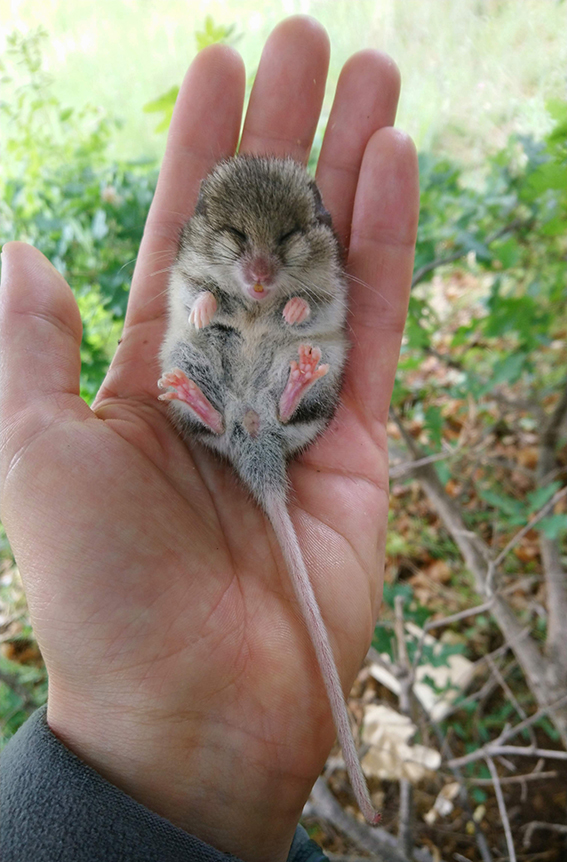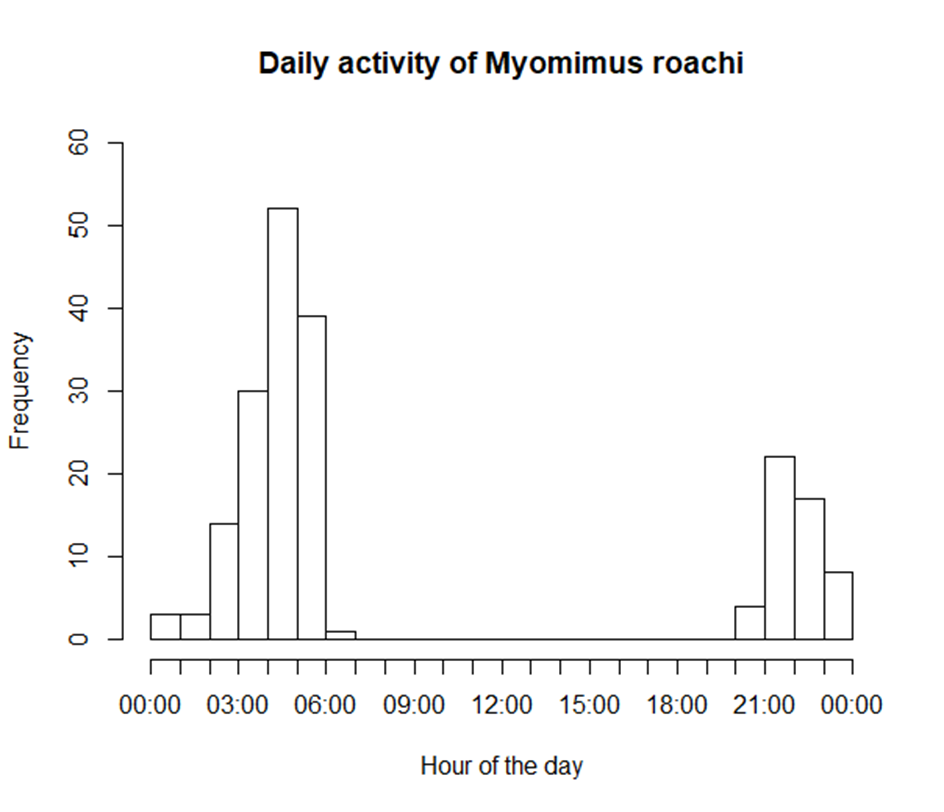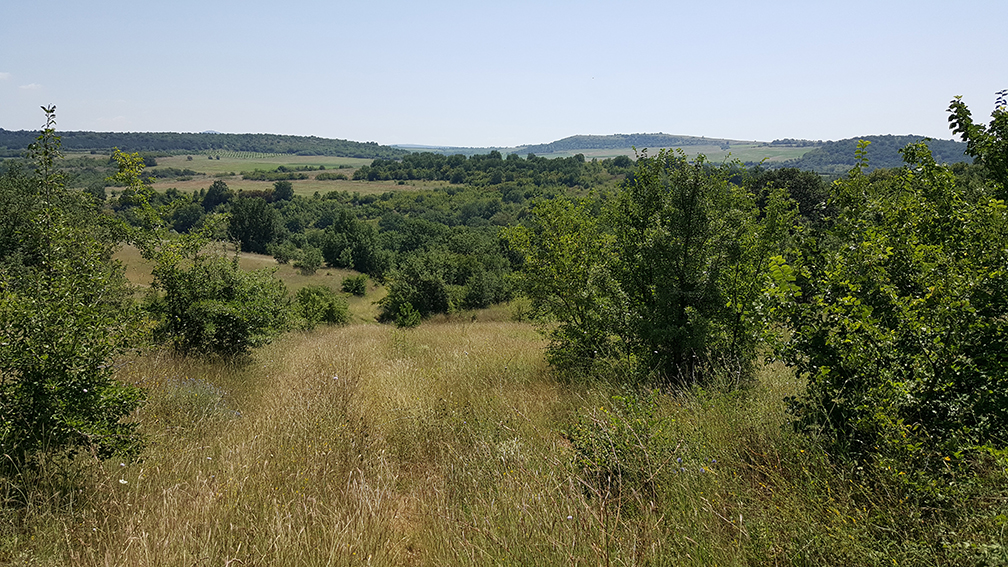
Missing for almost 40 years the Mouse-tailed dormouse (Myomimus roachi Bate 1937) was rediscovered in 2017 when during a routine field survey a single specimen was caught. In the following year, 20 next boxes were placed in two plots and checked occasionally. Thanks to a PTES grant more intensive field surveys could be conducted in 2019 and 2020.
The work took place in southeast Bulgaria – Sakar mountain, where the species was rediscovered in 2017 (Nedyalkov et al., 2018). In 2019 Nedko Nedyalkov and his team placed 70 nest boxes, which they monitored in the following two years. They also placed 100 live traps (50 type Longworth and 50 Deufa traps) and 4 wildlife cameras.
For the two years in total, they realised 4200 trap nights and checked the nest boxes twice per month during the snow-free months (April-November). As a result of both methods, they got 1595 captures of small mammals from 9 species. The small mammal community is dominated by the yellow-necked wood mouse (Apodemus flavicollis), the most numerous one forming 73,2% of all captures; and two subdominants glirids – forest dormouse (Dryomys nitedula) and Roach’s mouse-tailed dormouse (Myomimus roachi) with 17% and 7% respectively of all captures. Some other small mammals as bicolored white-tooted shrew (Crocidura leucodon), lesser white-tooted shrew (Crocidura suaveolens), edible dormouse (Glis glis), field mouse (Apodemus agrarius), wood mouse (Apodemus sylvaticus), and Macedonian mouse (Mus macedonicus) were occasionally captured.
All captured dormice were sexed, weighed, microchipped, and released. In those two years, they had 89 forest dormice, 35 Roach’s mouse-tailed dormice, and 7 edible dormice (Table 1).
| 2019 | Individuals | Captures |
|---|---|---|
| Dryomys nitedula | 51 | 110 |
| Myomimus roachi | 23 | 46 |
| Glis glis | 2 | 2 |
| 2020 | Individuals | Captures |
| Dryomys nitedula | 56 | 110 |
| Myomimus roachi | 19 | 48 |
| Glis glis | 6 | 9 |
Life history of Roach’s Mouse-tailed dormouse

Nedko and his team collected crucial data and information about the ecology and biology of Roach’s mouse-tailed dormouse. It seems the mouse-tailed dormouse is a lazy dormouse – it is active for only 4 months in the year – between May and August. First dormice emerge from hibernation at the end of April (the earliest record: 22 April). No dormouse activity is detected after August by live-trapping, checking nest-boxes, or camera traps.
This short active period is quite unusual, having in mind the hot Mediterranean climate in the region, even in September and October with a daily temperature of 25 to 33 oC. For instance, the forest dormice are active at least 8 months per year, from April till November.
Probably this is a natural strategy for a species to reduce predation and competition with other species. In the study area, Nedko and his team documented the presence of several potential predators on dormice, such as a stone marten (Martes foina), wild cat (Felis silvestris), badger (Meles meles), golden jackal (Canis aureus), red fox (Vulpes vulpes), and some snakes – Caspian whipsnake (Dolichophis caspius) and horned viper (Vipera ammodytes).

During this short active period, it breeds only once. Maybe, this is the cause the species is so rare, but these results are preliminary to make any further conclusions. In 2020 the first time breeding in the nest-boxes was recorded as there were 3 litters with 8, 5, and 4 young, respectively.
We collected dozens of gigabytes with pictures and videos with the wildlife cameras. They are partly analysed. Figure 1 shows the daily activity of the Roach’s mouse-tailed dormouse based on the analysis of wildlife camera images from 2019 and 2020.
It seems the Roach’s mouse-tailed dormouse eagerly uses the nest boxes, especially in the second year after they were set when 3 females breeding in the boxes were found. In winter, the dormice leave the nest boxes and hibernate somewhere else, most probably underground.
The use of nest-boxes appears to be an effective method to survey Roach’s mouse-tailed dormouse, as well as other species of dormice. The plan is to use this method to set up a national monitoring scheme, including other regions where the species might live.
Follow-up
According to the Bulgarian Biodiversity Conservation Act, action plans for endangered species have to be made. The Habitat Foundation urged the Bulgarian Ministry of Environment and Water to have this action plan made. In 2020 the Ministry ordered to have this action plan made.
Within the project, we collected valuable information and data about the species activity, its numbers, and habitat preferences, which is crucial for understanding the species biology and helps us in planning and taking any conservation actions. Because our survey was done on a small territory of its possible distribution, we want to extend our research to a national level and collect more data about the species status and start several monitoring plots with nest boxes.
Support this project with a donation
Reference
Nedyalkov, N., G. Popgeorgiev, A. Staneva. 2018. Updated distribution of the elusive Roach’s mouse-tailed dormouse, Myomimus roachi Bate, 1937 (Mammalia: Rodentia: Gliridae) in Bulgaria. Historia naturalis bulgarica 29: 3–8.
See also ‘Discovering dormice in Bulgaria‘.







